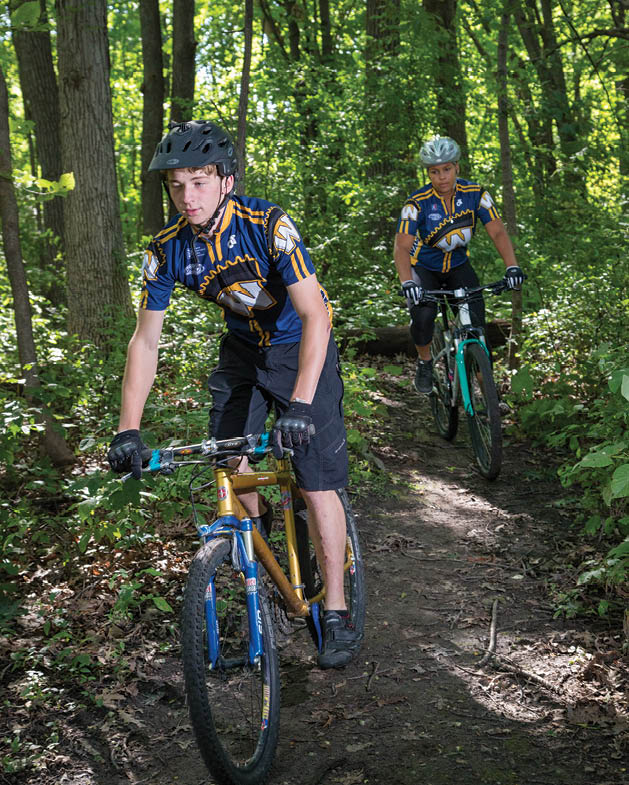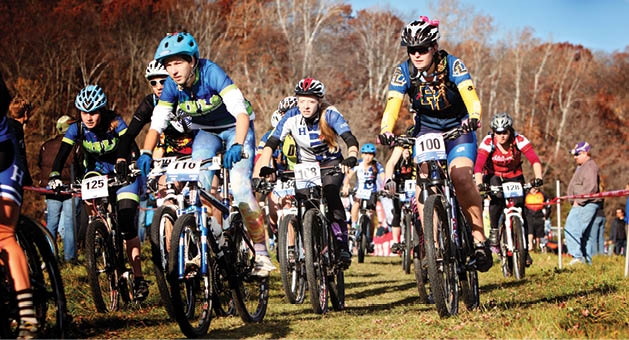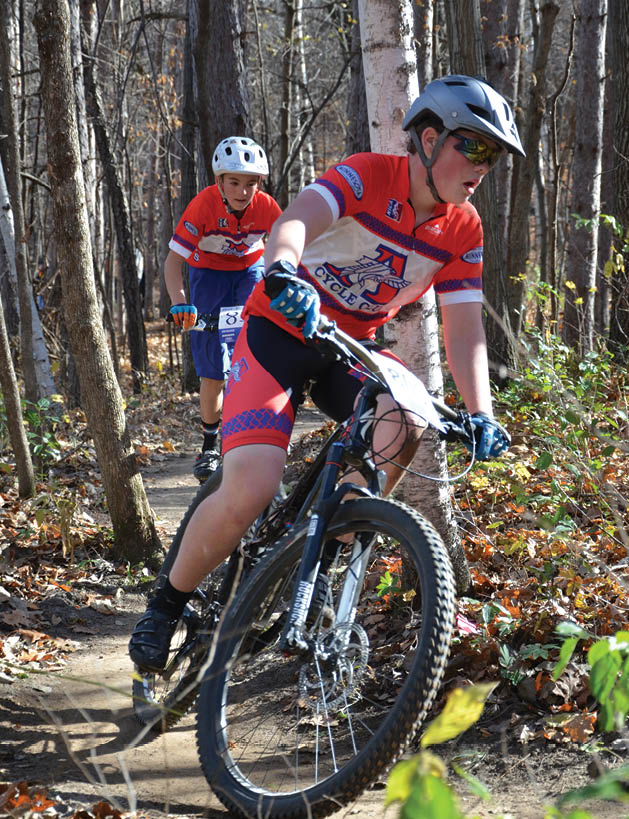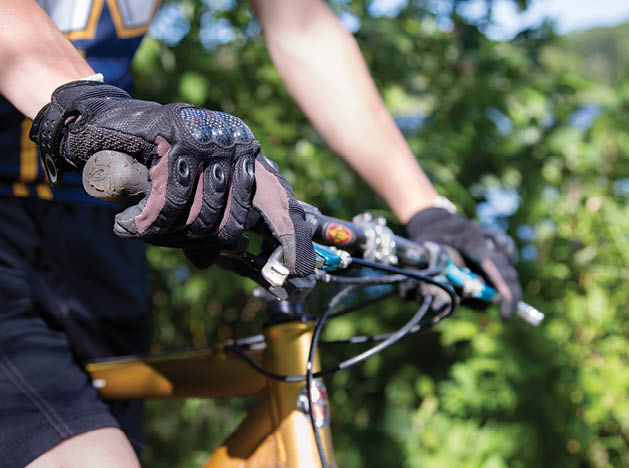It’s a sunny but frosty morning in mid-October. A light fog rolls through the hills, otherwise set ablaze as the rising sun kisses their changing leaves and native grasses. The air holds the musty essence of damp fallen foliage, as a cluster of volunteers tramps the early morning singletrack, marking the trail for more than 750 middle school and high school athletes who perhaps just the year before would never have classified themselves as such. Dozens of these students hail from Plymouth, part of Wayzata and Robbinsdale-Armstrong’s Minnesota State High School mountain biking league (MSHSL).
Soon the early morning silence is filled with the nervous chatter of teenagers, each prepping for his or her respective event. The co-ed sport sends off racers in a group start by age level—first the junior high, then the freshman, sophomore, JV and varsity. Racers travel between 5- and 10-mile loops, generally, with the number of loops dependent again on age/experience. Courses are a combination of winding grassy fields, gravel roads and singletrack that twist around trees and up and down rolling hills, providing a competitive aerobic activity and an environment of camaraderie that’s palpable at each of the team tents post-race. And that’s just as the organizers intend it.
A Brief History
The MSHSL is a branch of the National Intercollegiate Cycling Association (NICA), which launched in 2009 in California with the mission of introducing mountain biking to younger kids as an accessible, individual and also team sport that can become a lifelong pastime; the goal is to have a presence coast-to-coast by 2020, and the association currently has affiliates in 14 states. Remarkably, MSHSL is just four seasons old and is one of the fastest growing subsets in the nation, with more than 50 teams already formed and another eight or so in the works. Eleven of these offered varsity letters last year, with 20 to 25 expected to offer letters this year. (Wayzata and Armstrong host club sports.)
Because teams are often loosely affiliated with a school district, each has its own “birth story,” says Sheryl Golin, head coach and founder of Wayzata’s 2-year-old team; theirs is through Wayzata Community Education. Erik’s Bike Shop in Ridgedale is the Wayzata team shop partner; both Erik’s and Penn Cycles are sponsor shops across the metro. There, students can get team jerseys and bike needs, sometimes at special prices. In addition to students from Wayzata High School, Golin says her biggest “feeders” are East Middle, Central and West Middle schools. “They make up two-thirds of our team,” she says. “Part of the reason is seventh- and eighth-graders aren’t as involved yet. Some are just finding their way. Mountain biking is sort of an indie sport, so there are no expectations.”
Like Golin, Bill Welsh is both head coach and founder of the cycle club in the Robbinsdale district, which is in its second year this season. “There’s Division 1 teams and Division 2 teams,” he says, noting D2 are sometimes smaller, composite teams from multiple schools. “Most teams start out Division 2, but we ended up in our first year, because there was so much interest, a Division 1 team. We had 20 kids in our first year that were very interested and engaged.”
Training Grounds
So what do these events entail for students who perhaps have never participated in an organized sport before? Middle school races are quite accessible, usually just one lap of the course. “They can be done in 20 minutes,” Golin says. “[Students can also] race up a level if they are confident and aerobically capable.” Varsity competitions, in comparison, often last an hour and a half.
To prepare for this variety and rigor, Welsh starts holding three 3-hour practices a week in early July. “Each day, we start with stretching/balance/plyometric,” he says. “Mountain biking is all about balance, so this is very important. Sometimes we do yoga. Then we teach bike skills: It’s important kids understand how to handle a bicycle, so we teach a lot of physics, center of gravity, momentum, brake and turn. Then we’ll ride, usually to [Theo Wirth] mountain bike trail—coming from Armstrong that’s 8 miles on road, then we’ll ride off road 6 to 10 miles, then we’ll ride back to the school.” Welsh, along with volunteer coaching assistants and ride leaders are with the kids at all times, so often the younger or less-experienced kids will go with one ride coach, while older kids go out first and further to give all levels of workout. The team also works on off-bike fitness, too.
Golin takes a similar approach to practice, with obstacle work first, then a ride for endurance, concluding with a development game of some sort. “It’s new and developing skills, and all games are equalizing and fun,” she says. “Here’s the beauty: Kids don’t get scared very easily. [This sport] is for adventurous kids; the ones who are interested are already just a different type of person.”
When it comes to equipment, the only requirement is that bikes—each athlete provides his or her own—have wide tires, and Golin highly recommends front suspension. “It’s kind of bumpy on their little bodies,” she says. Helmets are required, of course, “and if they’re newbie newbies, or road riders, I suggest flat pedals at first,” she says, as opposed to clipless pedals, which create a more efficient ride but can also get riders into trouble if they aren’t able to get their feet unattached from their pedals in the event of a challenging hurdle or imminent crash.
“Cycling is both a lot of fun—it’s a whole lot of fun to ride your bike through the trails—and it’s also a lot of work,” Welsh says. “This is designed for kids who haven’t mountain biked before: It’s pretty easy in terms of technical skills, but [aerobically] hard because of biking hills. It does take a lot of mental commitment and a lot of time to just get stronger.”


Benefitting All
The benefits of this sport are wide-ranging for students, parents, coaches and community. “We’re focused on developing kids through mountain biking,” Welsh says. “We’re very much about building character, giving opportunities to grow as people. [NICA] has core values of inclusiveness, and we want all kinds of kids from all different backgrounds and ability levels.”
To this end, all teams do some sort of community work: Welsh has taken Armstrong’s team trail-building at Theo Wirth park, as well as to three to four community events for volunteer work, as “it’s important to teach the students to give back,” he says. “We believe volunteering builds community and builds character,” Golin adds. “Our riders will develop their character while on the team—sportsmanship comes into play—and grow into strong and capable young adults who are prepared for most any challenge, and are prepared to lead by example, using dedication, perseverance and discipline in an atmosphere of good humor and sportsmanship.”
It’s notable that female riders make up only 25 percent of most MSHSL teams; student Josie Welsh balks at this unfortunate norm. The daughter of the Armstrong coach, her mild-mannered demeanor and humble approach to her accomplishments belie the elite woman rider status she’s garnered in off-season racing in the biweekly Minnesota Racing Series, among others. She started mountain biking one day when her dad took her older brother on a ride; she was so angry to be left out, she went on her own. She hasn’t looked back—though Dad joins her now—and even has a job as a bike mechanic at Erik’s in St. Louis Park.
“I work with a group of women called the Crank Sisters who try to get women and girls on bikes,” she says. “Specifically mountain bikes. We host tryout sessions for people who don’t have the equipment and can’t make the cost commitment—we do that through MSHSL. They can try a bike on trails for free. I like to advocate for them; we gotta get girls on bikes.”
The aerobic value coaches allude to is recognized by the kids as well. “My skill has gone up,” Armstrong sophomore rider Damon Barli says. “I’m in way better shape. Now I ride every day.” Coast to coast, 6,000 participants in the league spend 348 hours apiece, on average, on mountain biking each season.
Luke Sicora is a freshman this year, riding in the sophomore category, and he placed sixth overall in the high school cycling race season totals for the freshman category last year. “He was a little guy and very quiet. It was fun to watch him gain confidence and make it onto the podium at every race,” Welsh says. Mom Kristina Sicora agrees: “I’ve seen physical and mental improvements,” she says of her two boys who will be on the team this year (12-year-old Leif will ride with the middle schoolers). “[Luke] has the drive to compete; he likes the camaraderie of being around his friends. I’ve seen improvements in social and academics, too.”
“I think I’ve become a lot happier,” says Josie Welsh, who will ride varsity for Armstrong this year. “I was jumping between sports, trying to find something I really enjoyed, and I couldn’t, and now this is the only thing I’ve done since.”
Improved self-esteem is perhaps the biggest perk to student athletes involved in either Wayzata’s or Armstrong’s programs. “Everybody—not just kids—should at least try it once,” Luke Sicora says. “Some people get intimidated, but it’s really, really fun.”
High School League FAQ
Wayzata
head coach Sheryl Golin provides the following answers to frequently asked
questions.
What equipment do I need?
You
need a mountain bike with knobby tires and a certified helmet. Coaches will
check athlete’s equipment the first week of training. After that, riders are
expected to have checked their equipment prior to each practice. This includes
having your tires pumped to 30psi, a water bottle on your bike, an energy bar
in your back pocket, eye protection and bike gloves.
Is loaner equipment available?
See
the head coach. Depending on size, there might be an equipment option for you.
Do the kids do jumps and tricks or downhill racing?
No,
this is a cross-country race team. Obstacles like roots, branches and drops are
part of the practices and races, but are not the sole focus of the sport. This
is an aerobic sport similar to cross-country running or Nordic skiing.
Can I earn a varsity letter?
The
Wayzata Mountain Bike Team is currently not a high school sport and therefore
does not allow for sports lettering. It is our hope that in the future we will
gain that status. You can help us by recruiting more club members and being
great teammates these first few years.
Who is the competition?
Each
race is a state race. Riders from all over the Minnesota League race together.
Schools in the Lakes Conference have mountain bike teams, including Edina,
Minnetonka and Hopkins. Nearby districts also have teams—like Armstrong High
School in Plymouth, and Osseo and Maple Grove. There are more than 750 riders statewide
this year.
When are the races?
September
and October at five trailheads across Minnesota. See state league website for
details: minnesotamtb.org.
Do parents have to volunteer?
Yes.
The Minnesota League is completely volunteer-run. Since parents are
transporting student riders to races anyway, we ask that they sign up for a
volunteer shift during race day. (Examples include set up or take down, race
day mechanic, food/water support or course marshal.)
Do students need to volunteer?
Yes. As part of the mountain bike team, student riders will be expected to help on race days with course setup or tear down. The teams also help the community through trail-building for MORC and volunteer wrenching at FreeBikes4Kidz.
How much does it cost?
$195 through Community Ed. New riders will need to pay $50 for a team jersey (available at Erik’s bike shop). Returning riders can keep their same jersey (unless they’ve outgrown it). Individual races are $45, payable to NICA through PitZone, in the fall.


By the Numbers :: Minnesota State High School League
- 100% of participating students state they will ride bikes for the rest of their lives.
- 85% of participants have an improved GPA of 3.0 or greater
- Many teams voted to include trail stewardship as a team activity.
- 96% of student athletes report health and fitness benefits
- 50% of parents resume/start riding as a result of their child’s
participation









